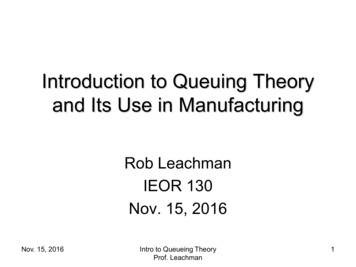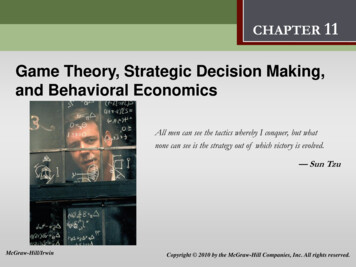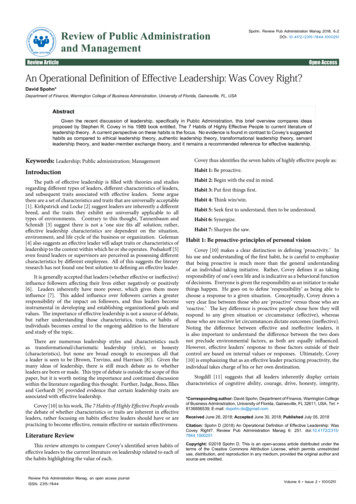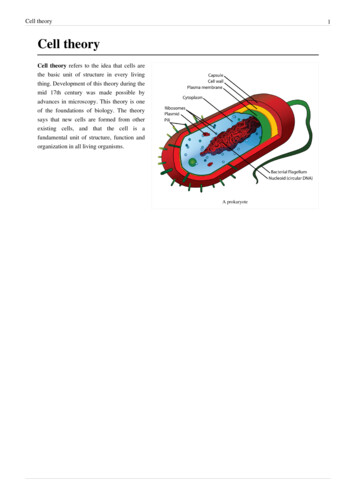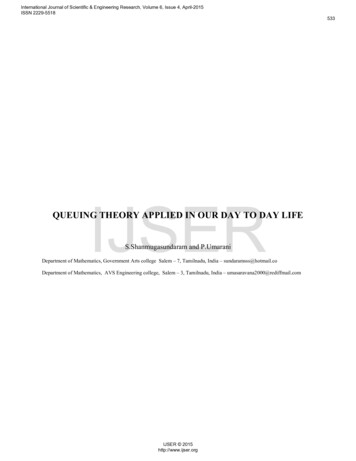
Transcription
International Journal of Scientific & Engineering Research, Volume 6, Issue 4, April-2015ISSN 2229-5518IJSERQUEUING THEORY APPLIED IN OUR DAY TO DAY LIFES.Shanmugasundaram and P.UmaraniDepartment of Mathematics, Government Arts college Salem – 7, Tamilnadu, India – sundaramsss@hotmail.coDepartment of Mathematics, AVS Engineering college, Salem – 3, Tamilnadu, India – umasaravana2000@rediffmail.comIJSER 2015http://www.ijser.org533
International Journal of Scientific & Engineering Research, Volume 6, Issue 4, April-2015ISSN 2229-5518QUEUING THEORY APPLIED IN OUR DAY TO DAY LIFES.Shanmugasundaram and P.UmaraniDepartment of Mathematics, Government Arts college Salem – 7, Tamilnadu, India – sundaramsss@hotmail.coDepartment of Mathematics, AVS Engineering college, Salem – 3, Tamilnadu, India – umasaravana2000@rediffmail.comAbstractThere are many situations in daily life when a queue is formed. Queuing theory is themathematical study of waiting lines and it is very useful for analyzing the procedure of queuingof daily life of human being. Queuing theory applies not only in day to day life but also insequence of computer programming, networks, medical field, banking sectors etc. In this paper,we analyze the basic features of queuing theory and its applications.KeywordsIJSERArrival process, service process, waiting time, system time, queue length, system length.IntroductionA queuing system which consists of the customers and the servers. Waiting line orqueues are in the schools, hospitals, bookstores, libraries, banks, post office, petrol pumps,theatres etc., all have Queuing problems. Queues are very familiar in our daily life. Queuingtheory is a branch of operations research because the results are used for making decisions aboutthe resources needed to provide service [9]. Many valuable applications of the queuing theoryare traffic flow (vehicles, aircraft, people, communications), scheduling (patients in hospitals,jobs on machines, programs on computer), and facility design (banks, post offices,supermarkets). A.K.Erlang (1878-1929) Danish Engineer who is called the father of Queuingtheory. He published his articles relating to the study of congestion in telephone traffic. Aqueuing theory is the Mathematics of waiting lines. A queuing system can be described by theflow of units for service, forming or joining the queue, if service is not available soon, andleaving the system after being served.Queue LengthProbability distribution of queue length can be obtained with the help of the givenProbability distribution of the arrival and service process. A large queue indicates poor servicefacility or a need for more space. A small queue indicates excess of service facilities.IJSER 2015http://www.ijser.org534
International Journal of Scientific & Engineering Research, Volume 6, Issue 4, April-2015ISSN 2229-5518Waiting time in QueueIt refers to the time spent by the customer in the queue before the commencement of hisservice.Waiting time in systemA basic concept in the analysis of a queuing theory is that of a state of the system. Itinvolves study of a system’s behavior overtime.Motive of the studyThis article gives the basic ideas of some important concepts and applications ofqueuing theory in the field. This paper aims to study of the applications of library management,bank ATMs, hospitals, traffic system, banking, toll plaza, railway station and computer system.Library managementA library is an organized collection of books, and some special materials like audio orvisual materials, CDs, cassettes, video tape, DVDs, e-books, audio books and many other typesof electronic resources. Scope of Queuing application in Libraries are circulation of books,counter service and allied services like reprography. The basic tasks in library are stacksmaintenance, membership management, selection of library materials, and planning theacquisition of materials.Bank ATMsIJSERIn ATM, bank customers arrive randomly and the service time i.e. the time customertakes to do transaction in ATM, is also random. We use queuing model to derive the arrival rate,service rate, utilization rate, waiting time in the queue and the average number of customers inthe queue. Queuing can help bank ATM to increase its quality of service, by anticipating, if thereare many customers in the queue [3].HospitalsQueuing models using for estimating waiting time of a patient, utilization of service,models system design, and models for evaluating appointment systems [10]. A queuing systemhelps minimizing the waiting time of patients and maximizing the utilization of the servers i.e.doctors, nurses, hospital beds etc. Queuing is not new but recently hospitals has begun to use iteffectivelyTraffic systemThe vehicular traffic flow and explore could be minimized using queuing theory in orderto reduce the delay on the roads. The role of transportation in human life cannot beoveremphasized. A basic model of vehicular traffic based on queuing theory. It will determinethe best times of the red, amber, and green lights to be either on or off in order to reduce trafficIJSER 2015http://www.ijser.org535
International Journal of Scientific & Engineering Research, Volume 6, Issue 4, April-2015ISSN 2229-5518congestion on the roads. Queuing also helps to reduce fuel consumption thereby saving moneyfor the Government to tackle problem of other sectors of the economy.BankingToday banks are one of the most important units of the public. Most banks used standardqueuing models. It is very useful to avoid standing in a queue for a long time or in a wrong lineand to give tickets to all customers. Bank is an example of unlimited queue length [1].Queuing is used to generate a sequence of customers' arrival time and to choose randomlybetween three different services: open an account, transaction, and balance, with different periodof time for each service.Toll plazaComputer simulation is one of the popular approaches to the design of toll plazas. Tollplaza configurations such as toll collection methods, number of toll booths, and types of vehicleshave been used here. Toll plaza performance measures such as average queue length, averagewaiting time, maximum queue length, and maximum waiting time at the tolls were comparedbetween two different types of representations of projected traffic volumes. Toll plaza designingfactors such as lane selection options, electronic toll collection(ETC)rates, and number of manualtolls were combined with traffic flow measure the specified toll performances .Findingappropriate values of input parameters for a traffic simulation model is always a challenge tosimulation model builders as well as to traffic engineers. For generating traffic flow in asimulation model, deterministic traffic counts for a time period can be used as an input parameterinto the model rather than considering a probabilistic distribution [6]. .IJSERRailway stationIn the country like India where Railway is one of the most popular and cheapest means oftransportation, it is always difficult to book confirmed tickets for the journey. The populationthat the country has it doesn’t match up with number of trains running various routes especiallythose connecting the metro cities. Indian Railway is trying to meet the ever increasing demand ofover billion people. The queuing system is used to avoid the inconvenience of passengers and itis feasible and the results are effective and practical.Computer systemMany jobs arrive sequentially at a computer system in accordance with a Poissonarrival process, and the execution time of a job is a random variable. Jobs are executed in theorder of arrival, if the computer is busy when a job arrives, the job is placed in a queue. In theterminology of queuing theory the computer is the “server” and the jobs are “customers”. Thelogical structure of the single server queuing model can be restored with a simple device. Let theserver represent the combined resources of computer and operator.State of the Queuing system(1).Transient stateIJSER 2015http://www.ijser.org536
International Journal of Scientific & Engineering Research, Volume 6, Issue 4, April-2015ISSN 2229-5518(2). Steady state(3).Explosive stateTransient stateA queuing system is said to be in transient state when its operating characteristics,arrivals, waiting time and service time of the customers are dependent on time.Steady stateA queuing system is said to be in a steady state when its operating characteristics,arrivals, waiting time and service time of the customers are independent on time.Explosive stateIf the arrival rate of the system is more than its servicing rate, the length of the queue willgo on increasing with the time and will tend to infinity.Classification of Queuing ModelsIJSERModel I (M/M/I) : ( /FCFS)Model I (M/M/I): ( /FCFS)Model II (M/M/I): ( /SIRO)Model III (Birth-Death process) (M/M/I) : ( /FCFS)Model IV (M/M/I): (N/FCFS)Model V (M/M/C): ( /FCFS)Model VI (M/E/I): ( /FCFS)Model VII (M/M/R): (K/GD); K RModel VIII – Power supply ModelModel IX – D/D/IModel X – M/D/IModel XI (M/G/I) : ( /FCFS)Kendall NotationA/S/m/B/K/SDA: arrival processS: service time distributionIJSER 2015http://www.ijser.org537
International Journal of Scientific & Engineering Research, Volume 6, Issue 4, April-2015ISSN 2229-5518m: number of serversB: number of buffers (system capacity)K: population sizeSD: service disciplineArrival processThe number of customers arriving per unit of time is called arrival rate. Random arrivalsare described by the Poisson distribution.Service time distributionThe number of customers served per unit of time is called service time. The service timesare described by the exponential distribution.Service DisciplineThis is the manner by which customers are selected for service when a queue hasformed. The most common discipline is FCFS – First Come, First Served. The other disciplinesare LCFS – Last Come First Served and SIRO – Service In Random Order and GD – generalservice discipline and including priority.IJSERNumber of ServersA queuing system is called one server model, when the system has server only and amulti- server model when the system has a number of parallel channels each with one server [7].IJSER 2015http://www.ijser.org538
International Journal of Scientific & Engineering Research, Volume 6, Issue 4, April-2015ISSN 2229-5518Notations used in queuing systemλ – Mean arrival rate of customersµ – Mean service time– Average number of customers in the system.IJSER– Average number of customers in the queue.– Average waiting time of a customer in the system.– Average waiting time of customers in the queue.n – Number of customer in the system.– Utilization factor for the service system.c – Number of service Channels.Little's formulaIn his connection, it is relevant to mention one of the important and useful relationship inqueuing theory which holds under fairly quite general conditions. It is known as Little's formula,a rigorous proof of which was given by Little (1961).It is given by λW where λ is arrivalrate, E(L) is the expected queue length under steady state and W is the steady state expectedwaiting time in the system.Queue NetworksNetwork of Queues can be described as a group of nodes where each of the nodesrepresents a service facility of some type. Customers can arrive from outside the system to anynode and may leave the system from any node [2].Therefore, customers may enter the system atsome node, can transverse from node to node in the system and finally can leave the system atsome other node,not all customer necessarily enter and leave at the some node or taking the sameIJSER 2015http://www.ijser.org539
International Journal of Scientific & Engineering Research, Volume 6, Issue 4, April-2015ISSN 2229-5518path once after entering the system. Also customers can return to nodes already visited, skipsome nodes entirely or even choose to remain in the system forever.Classification of Networks(i)(ii)(iii)Open NetworksClosed NetworksMixed NetworksOpen NetworksIn an open queuing network, customers enter the system from outside and after service atone or more queues, eventually leave the system.Closed NetworksA closed queuing network does not have any external arrivals or departures. It representsa situation where a fined number of jobs circulate in the system, moving from one queue to thenext, getting served at individual queues. No jobs enter the system nor does any job leave thesystem.IJSERMixed NetworksNetwork has multiple job classes and is open with respect to some classes but closed withrepeat to the others.Serious QueuesIn Queuing model in which there are a series of service stations through which eachcalling unit must progress prior to leaving system. There are several types of network of Queuesfor which customers are not allowed to visit previously visited nodes. The first series model to beconsidered is the sequence of queues with no restriction on the waiting’s room capacity betweenthe stations. For example, a physical examination for a patient undergoes through a series ofstages lab tests, electrocardiogram, chest X -ray, etc.Fuzzy queuesThe fuzzy queues are first analyzed by R.J.Lie and E.S.Lee in 1989. In poisson arrivalqueuing system is a fairly reasonable assumption, the arrival rate and service rate are really morepossibilistic than probabilistic. Furthermore, in many practical situations the parameters λ(arrival rate) and µ (service rate) are frequently fuzzy and cannot be expressed in exact terms.Thus linguistic expressions for these parameters such as " the mean arrival rate is approximately5" and "the mean service rate is approximately 10" are much more realistic under thesecircumstances. Fuzzy queues are much more realistic than the commonly used crisp queues.Fuzzy set theory has been applied to some queuing systems to provide wider applications ininstrumentation technology, information technology and communication technology.IJSER 2015http://www.ijser.org540
International Journal of Scientific & Engineering Research, Volume 6, Issue 4, April-2015ISSN 2229-5518ConclusionThe formation of queue is a common phenomenon which occurs whenever the currentdemand for a service exceeds the current capacity to provide that service. Queuing systems areuseful throughout society. The capability of these systems can have an important result on thequality of human life and productivity of the process. Queuing systems are successfully used forthe performance analysis of different systems such as computer, communications, transportationnetworks and manufacturing. In addition, examples of queuing theory applications are given.This analysis provides some fundamental concepts of queuing theory and their applications.References[1]. Ahmed.A.S.and.Huda K.T (2011) Automatic queuing model for Banking[2]. Alex and Simmens .C (2013). Queue Management software applications .[3]. Bhavan Patel and Pravin Bhathawala ( 2012 ) Case Study for Bank ATM Queuingmodel.[4]. Daniel.A. – Introduction to Queuing theory.IJSER[5]. Kanti Swarup, P.K.Gupta, Man Mohan (2008) – Operations Research[6]. Kim.B.J.(2011). Conceptualization of traffic flow for designingToll Plazaconfiguration: A case study using simulation with estimated traffic volume.18 (1): 51-57.[7]. Ajay kumar Sharma (2013) Queuing theory approach with queuing model: A study[8]. Medhi.J. (2009) Stochastic Process.[9]. Moore.B.J. (1977) – Use of Queuing theory for problem solution in Dallas, Tex,Bureau of Vital Statistics[10]. Samuel Fomundam, Jeffrey Herrmann (2007) A survey of Queuing theoryapplications in Healthcare.IJSER 2015http://www.ijser.org541
A library is an organized collection of books, and some special materials like audio or visual materials, CDs, cassettes, video tape, DVDs, e-books, audio books and many other types of electronic resources. Scope of Queuing application in Libraries are circulation of books




